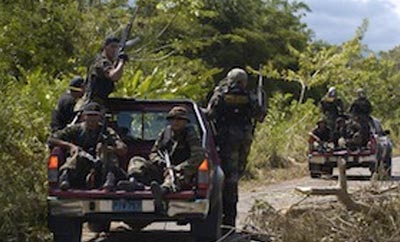Government figures show Peru is on track to meet its 2014 coca eradication goals, but the authorities’ focus on central areas at the expense of the VRAEM region betrays ongoing concerns about the abilities of the Shining Path guerrillas to disrupt efforts.
According to Minister of the Interior Daniel Urresti, Peru eradicated 16,591 hectares of coca so far this year, reported AFP, meaning the country is on track to achieve its goal of eradicating 30,000 hectares by the end of 2014. Urresti added that antinarcotics police have also focused on destroying drug laboratories and clandestine landing strips used by traffickers.
At a recent United Nations meeting, the president of the National Commission for Development and Life Without Drugs (Devida), Alberto Otarola, stated that the country’s crop substitution programs in the San Martin region — located in central Peru’s Upper Huallaga Valley — have been successful and should serve as “an example for South America and the world.” Otarola added that in the Monzon Valley, which is part of the Huallaga Valley, the government has reduced coca cultivation from almost 8,000 hectares in 2011 to only 227.
InSight Crime Analysis
Peru, the world’s top cocaine producer, has recently revamped its coca policies after the government replaced their hardliner anti-drugs chief and scaled back forced eradication plans. However, it is likely the change in approach was not only influenced by politics but also by the Shining Path guerrilla group, which have all but disappeared in one key coca growing region, but made another into a stronghold.
Forced eradication targets laid out at the start of the year focused heavily on the Apurimac, Ene and Mantaro River Valleys (VRAEM), a Shining Path stronghold where more than 57 percent of the country’s coca was grown in 2013. However, Peruvian authorities later announced security forces would no longer carry out forced eradication in the area and cut their coca eradication goal from 15,000 to 5,000 hectares. Officials said the change in policy came in response to information the Shining Path had offered to help locals combat eradication.
SEE ALSO: Shining Path Profile
Instead, the government appears to have shifted its focus to other areas where the Shining Path no longer poses a threat. The Upper Huallaga Valley — the site of the crop substitution program vaunted by Otarola — was a former Shining Path stronghold until the 2012 capture of guerrilla leader Florindo Eleuterio Flores Hala, alias Artemio. Since the loss of Artemio, his Shining Path faction, which had helped protect coca cultivations, has faded away, allowing the authorities to begin new eradication programs in the region.
Meanwhile, there are reports of up to 10 drug flights entering the VRAEM region every day, transporting an estimated total of between 54 and 72 tons of cocaine a month.

